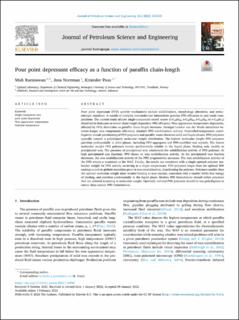| dc.contributor.author | Kurniawan, Muh | |
| dc.contributor.author | Norrman, Jens | |
| dc.contributor.author | Paso, Kristofer Gunnar | |
| dc.date.accessioned | 2022-02-09T07:57:58Z | |
| dc.date.available | 2022-02-09T07:57:58Z | |
| dc.date.created | 2022-02-04T12:24:20Z | |
| dc.date.issued | 2022 | |
| dc.identifier.citation | Journal of Petroleum Science and Engineering. 2021, 212, . | en_US |
| dc.identifier.issn | 0920-4105 | |
| dc.identifier.uri | https://hdl.handle.net/11250/2977843 | |
| dc.description.abstract | Pour point depressant (PPD) activity mechanisms include solubilization, morphology alteration, and steric/entropic repulsion. A wealth of complex intermolecular interactions governs PPD efficacies in real crude compositions. The current study utilizes single-component model waxes (n-C24H50, n-C28H58, n-C32H66 or n-C36H74) dissolved in dodecane to reveal chain-length dependent PPD efficacies. Wax appearance temperature depression, effected by PPD, diminishes as paraffin chain-length increases. Stronger London van der Waals attractions between longer wax components effectively diminish PPD solubilization activity. Controlled-temperature centrifugation reveals partitioning of PPD polymers and paraffin waxes between solid and liquid phases. PPD polymers typically contain a polydisperse molecular weight distribution. The highest molecular weight PPD polymers partition preferentially to solid phases, including PPD aggregates and PPD-modified wax crystals. The lowest molecular weight PPD polymers remain preferentially soluble in the liquid phase, binding only weakly to precipitated wax. The presence of precipitated wax counteracts the solubilization activity of PPD polymer. At high precipitated wax fractions, PPD shows no wax solubilization activity. As the precipitated wax fraction decreases, the wax solubilization activity of the PPD progressively increases. The wax solubilization activity of the PPD attains a maximum at the WAT. Finally, the results are consistent with a single optimal polymer molecular weight for PPD activity occurring at a single temperature. PPD polymers larger than the optimal MW undergo a coil-to-globule transition prior to wax crystallization, deactivating the polymer. Polymers smaller than the optimal molecular weight show weaker binding to wax crystals, consistent with a smaller Gibbs free energy of binding, and partition preferentially to the liquid phase. Modern PPD formulations should utilize polymers that are tailored according to molecular weight. Optimally tailored PPD polymers should be less polydisperse in nature than current PPD formulations. | en_US |
| dc.language.iso | eng | en_US |
| dc.publisher | Elsevier Ltd. | en_US |
| dc.rights | Navngivelse 4.0 Internasjonal | * |
| dc.rights.uri | http://creativecommons.org/licenses/by/4.0/deed.no | * |
| dc.title | Pour point depressant efficacy as a function of paraffin chain-length | en_US |
| dc.type | Peer reviewed | en_US |
| dc.type | Journal article | en_US |
| dc.description.version | publishedVersion | en_US |
| dc.source.volume | 212 | en_US |
| dc.source.journal | Journal of Petroleum Science and Engineering | en_US |
| dc.identifier.doi | 10.1016/j.petrol.2022.110250 | |
| dc.identifier.cristin | 1997777 | |
| dc.source.articlenumber | 110250 | en_US |
| cristin.ispublished | true | |
| cristin.fulltext | original | |
| cristin.qualitycode | 2 | |

